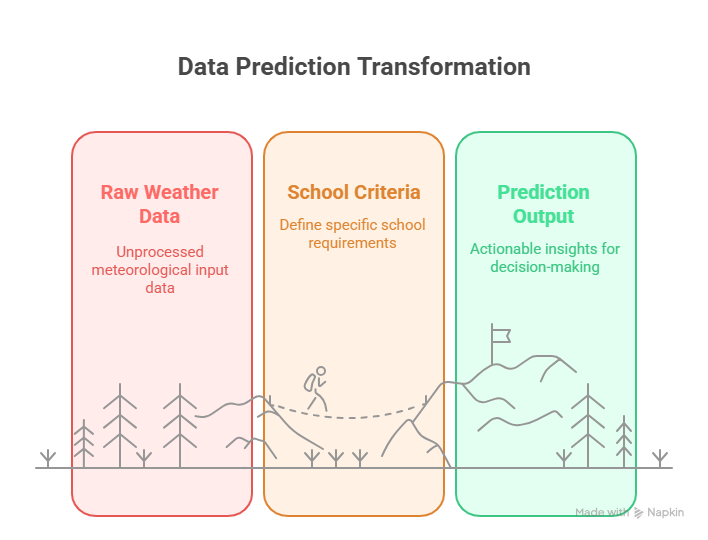The Ultimate Snow Day Calculator Guide : Predict Snow Days Like a Pro
As winter sets in, schools and families alike eagerly await news of snow days. A snow day calculator has become an essential tool for predicting school closures due to snow, ice, or severe weather. These online tools analyze weather data, school policies, and other variables to offer an accurate prediction of whether your school will be closed for the day. Whether you’re a parent, student, or school administrator, these tools are designed to save you time and provide peace of mind.
In this ultimate guide, we’ll explore the ins and outs of snow day calculators, how they work, their features, and the best tools available. We’ll also answer some common questions to ensure you’re fully prepared for the next snowstorm.
What Is a Snow Day Calculator and How Does It Work?
A snow day calculator is a prediction tool that helps you determine whether your school will close because of severe weather. These calculators use algorithms to evaluate data such as snowfall predictions, temperature, wind speed, and local school policies to give you a prediction. Instead of waiting for official announcements or scrambling to check the news, you can simply enter your location and get an instant forecast on whether a snow day is coming.
How Does It Work?
- Data Input: Enter your school’s location, the date, and any specific criteria.
- Weather Data: The tool analyzes weather data such as predicted snowfall, ice, or wind.
- School Criteria: Local school district policies are taken into account. For example, one district may call a snow day with only a few inches of snow, while another might wait for more.
- Prediction: Based on this analysis, the calculator will provide a prediction of whether school will be canceled or delayed.
Snow day calculators are a great way to plan ahead, ensuring that you’re prepared for the possibility of a snow day without relying on last-minute announcements.
How Snow Day Calculators Work
Snow day calculators rely on a combination of technology and local data to deliver accurate predictions. Here’s a breakdown of the science that makes these tools so effective:
Weather Data Integration
Snow day calculators pull data from weather services such as the National Weather Service or AccuWeather. The tool checks for weather conditions like:
Snow Accumulation: How much snow is expected to fall.
Temperature: Extreme cold temperatures can also lead to school closures, even without snow.
Precipitation: Ice, freezing rain, or sleet can also prompt school closures.
Local School Policies
Every school district has its own set of rules regarding snow days. For example:
Some schools may close if there’s a certain number of inches of snow.
Others may consider road conditions, wind chill, or the safety of buses and students.
Snow day calculators often ask for input about the school’s criteria to help deliver a more accurate prediction.
Historical Weather Patterns
Many snow day calculators use historical data from past years to help predict future closures. By analyzing how often schools closed under similar weather conditions, these calculators can adjust their predictions accordingly.

Key Factors That Affect Snow Day Predictions
Several factors play a role in determining whether a school will close, and snow day calculators use these factors to generate accurate predictions. Let’s take a look at the key elements that influence snow day calculations:
Weather Conditions
Weather conditions are the primary factor in determining if schools will close. These conditions include:
Snowfall Amounts: The heavier the snow, the higher the likelihood of a school closure.
Temperature: In areas where temperatures dip significantly below freezing, even a small amount of snow can cause school closures
Ice or Freezing Rain: Ice accumulation on roads and walkways can make travel hazardous, prompting school closures.
School District Policies
Each school district has different criteria for calling a snow day. For example, some districts may close when there are more than 4 inches of snow, while others may wait for more severe conditions. Districts may also factor in local road conditions, which could affect buses and student safety.
Road Conditions
One of the most critical factors is the safety of travel. If roads are unsafe, school closures are more likely. School districts may monitor road conditions, and snow day calculators may incorporate real-time data about road closures, accidents, or hazardous conditions in their predictions.
Other Environmental Factors
In some cases, school closures may occur even without significant snow. For example, freezing rain or wind chill factors can make conditions dangerous for students and staff, leading to a decision to cancel school.
The Pros & Cons of Using a Snow Day Calculator
Snow day calculators offer numerous benefits but also come with their own set of limitations. Here’s a look at the pros and cons of relying on these tools:
Pros
Convenience:
Snow day calculators provide immediate predictions, saving you time and reducing anxiety about school closures.
Accurate Predictions:
By analyzing real-time weather data and local school criteria, these tools can provide accurate forecasts that are updated frequently.
Easy to Use:
With just a few clicks, you can receive a prediction without having to manually check multiple sources.
Cons
Limited Accuracy:
While snow day calculators are reliable, they can’t account for sudden, unexpected weather changes. A storm could worsen or improve faster than predicted, affecting school decisions.
Regional Variations
In rural areas or regions with less weather data coverage, snow day calculators may not be as accurate as in urban areas.
Over-Reliance
Relying too heavily on calculators may lead to missed official announcements or overlooked local factors.
Top Snow Day Calculators Reviewed
Here are some of the top snow day calculators available, with an overview of their features, pros, and cons:
1. SnowDayPredictor.com
SnowDayPredictor.com provides real-time snow day predictions based on weather data and school district rules. This tool is highly reliable and includes features like:
> Customization for school-specific criteria.
> Detailed weather analysis and reliable forecasts.
Pros: Easy-to-use interface and real-time updates.
Cons: Less user-friendly in mobile format.
2. SnowDayCalculator.com
Another popular tool, SnowDayCalculator.com, allows users to predict snow days based on real-time weather and school district criteria. It’s simple to use and provides instant predictions.
Pros: User-friendly interface, accurate predictions.
Cons: Lacks some customization features for users in specific regions.
3. AccuWeather’s Snow Day Predictor
AccuWeather’s tool is backed by a trusted weather service, providing detailed predictions and localized forecasts. The accuracy is enhanced by real-time data and long-term weather predictions.
Pros: Detailed, localized forecasts
Cons: Somewhat more complex interface than other tools.
Conclusion
In conclusion, snow day calculators are invaluable tools for both parents and schools. They offer convenience, accurate predictions, and help you plan for winter weather more effectively. While no prediction tool is foolproof, these calculators provide a solid foundation for making informed decisions about school closures.
Whether you want to know if you’ll get a snow day or simply want to be prepared, snow day calculators are essential tools for the winter months.
